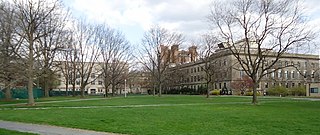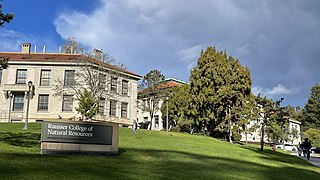
The Ontario Agricultural College (OAC) originated at the agricultural laboratories of the Toronto Normal School, and was officially founded in 1874 as an associate agricultural college of the University of Toronto. Since 1964, it has become affiliated with the University of Guelph, which operates campuses in Guelph and Ridgetown and formerly in Alfred and Kemptville, all in Ontario.

The New York State College of Agriculture and Life Sciences at Cornell University is one of Cornell University's four statutory colleges, and is the only College of Agriculture and Life Sciences in the Ivy League. With enrollment of approximately 3,100 undergraduate and 1,000 graduate students, CALS is Cornell's second-largest undergraduate college and the third-largest college of its kind in the United States.

Animal science is described as "studying the biology of animals that are under the control of humankind". It can also be described as the production and management of farm animals. Historically, the degree was called animal husbandry and the animals studied were livestock species, like cattle, sheep, pigs, poultry, and horses. Today, courses available look at a broader area, including companion animals, like dogs and cats, and many exotic species. Degrees in Animal Science are offered at a number of colleges and universities. Animal science degrees are often offered at land-grant universities, which will often have on-campus farms to give students hands-on experience with livestock animals.

Czech University of Life Sciences Prague is a university of agricultural education and research in Prague, the Czech Republic, established in 1906.

The University of Agriculture (UAF) is a public research university in Faisalabad, Pakistan. It is the second largest university of Pakistan by area with a covered area of 2550 acres as compared to Punjab University's 3000 acres which is the first largest.

The Rausser College of Natural Resources (RCNR), or Rausser College, is the oldest college at the University of California, Berkeley and in the University of California system. Established in 1868 as the College of Agriculture under the federal Morrill Land-Grant Acts, CNR is the first state-run agricultural experiment station. The college is home to four internationally top-ranked academic departments: Agriculture and Resource Economics; Environmental Science, Policy, and Management; Nutritional Sciences and Toxicology; and Plant and Microbial Biology, and one interdisciplinary program, Energy and Resources Group. Since February 2020, it is named after former dean and distinguished professor emeritus Gordon Rausser after his landmark $50 million naming gift to the college.
Jeonbuk National University is one of ten Flagship Korean National Universities founded in 1947, located in Jeonju, South Korea. Jeonbuk National University has been ranked 551–560th in the world by QS Top Universities Ranking in 2023.

IPB University is a state-run agricultural university based in the regency of Bogor, Indonesia.

The College of Biological Sciences (CBS) is one of seven freshman-admitting colleges at the University of Minnesota. Established in 1869 as the College of Science, the College of Biological Science is now located across both the Minneapolis and the St. Paul campuses. As of June 29, 2023, the dean of the College of Biological Sciences is Dr. Saara J DeWalt.

Sokoine University of Agriculture (SUA) is a public university in Morogoro, Tanzania, specializing in agriculture. The university is named after the country's second prime minister Edward Sokoine.

The University of Florida College of Agricultural and Life Sciences (CALS), founded in 1964, is a college of the University of Florida.

The Benguet State University (BSU) is a state university in the province of Benguet, Philippines. Its main campus is in La Trinidad.
In 2006, the Department of Bioproducts and Biosystems Engineering was established by merging Biosystems and Agricultural Engineering with Bio-based Products. The department continues to provide quality education and research in key areas of biomass/bio-based materials including wood and paper, environmental hydrology, erosion and stormwater management, renewable energy, life cycle assessment, bioprocessing and biotechnology, food engineering, air quality, precision agriculture, building systems, and sustainability, etc. As of August 2022, the current department head is Hua Zhao.
North Carolina State University's College of Agriculture and Life Sciences (CALS) is the fourth largest college in the university and one of the largest colleges of its kind in the nation, with nearly 3,400 students pursuing associate, bachelor's, master's and doctoral degrees and 1,300 on-campus and 700 off-campus faculty and staff members.
The University of Maryland College of Agriculture and Natural Resources is the agricultural and environmental sciences college of the University of Maryland and operates the Maryland Sea Grant College in cooperation with the University of Maryland Center for Environmental Science and the National Oceanic and Atmospheric Administration.
The College of Natural Resources and Environment at Virginia Tech contains academic programs in forestry, fisheries, wildlife sciences, geography, and wood science. The college contains four departments as well as a graduate program in the National Capital Region and a leadership institute for undergraduates.

Vietnam National University of Agriculture, until 2014 Hanoi University of Agriculture (HUA), is an education and research university specializing in the agricultural sector. The university is located in Trau Quy town, Gia Lam district, a Hanoi suburban area, about 12 km far from Hanoi city centre.

The Central Bicol State University of Agriculture, or simply referred to by its acronym CBSUA, is a state university in the province of Camarines Sur, Philippines, and is the regional center for higher learning in agriculture in the Bicol Region.

The Lilongwe University of Agriculture and Natural Resources (LUANAR) is a university outside Lilongwe, Malawi. It was formed in 2011 by a merger between Bunda College of Agriculture of the University of Malawi and Natural Resources College (NRC).

The University of Connecticut's College of Agriculture, Health, and Natural Resources (CAHNR) is the oldest of UConn's fourteen colleges, and teaches a wide range of subjects. It is the oldest agricultural school in Connecticut, originally established with two purposes, conducting agriculture research and teaching practical skills to modernize farming. The college describes its mission as working "toward a global sustainable future." To that end, besides conducting research and teaching, the college's faculty also work together with Connecticut communities on projects related to food systems, agriculture, human health, nutrition and physical activity, and environmental science.













